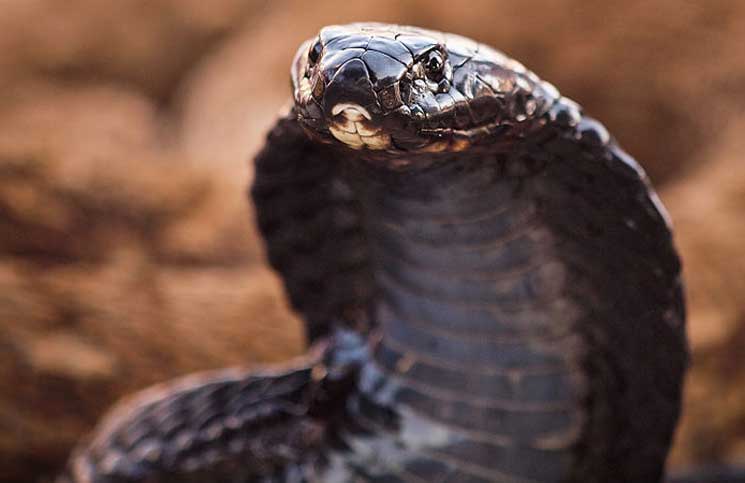Watching this riveting video of a Zebra Snake attacking an innocent Chameleon, makes you want to know more about this powerful Cobra. Well yes, the Zebra Snake, known also as Naja nigricincta, is a species of the Spitting Cobra of the genus Naja that belongs to the Elapidae family.
This unique Cobra had actually long been considered to be a subspecies of the black-necked spitting cobra (Naja nigricollis), but genetic differences have led researches to recognize it as a separate species. Don’t ask me if it was a necessary move, but that’s the situation.
The Zebra Snake and its Characteristics
There are two subspecies that are formally recognized under the Naja nigricincta:
1) The Naja n. woodi, also known as the Black Spitting Cobra, who’s solid black and can only be found in the hot desert terrains of southern Africa.
2) The Zebra Spitting Cobra, also known as the Western Barred spitting cobra, or just Zebra Snake, is native to parts of southern Africa, such as South Africa, Namibia and southern Angola. This beautiful cobra was given its name mainly because of the white or yellowish evenly spaced strips along its dark-brown to black body. The color of its ventral scales vary from white to orange, while its head and hood are black or dark brown.
Both subspecies of the Naja nigricincta are fairly small (smaller than the N. nigricollis), reaching lengths of less than 4.9 ft (1.5 m). The Zebra Snake can flatten its head and neck into a hood, in the same manner that other cobra species do.

The unique Venom of a Zebra Snake
It’s friendly name does not resemble a Zebra’s character at all. In Namibia, the Zebra snakes are known to torment villagers across the country, with dozens of reported bites every year. It seems that when it’s very hot and humid, these stripped cobras are somehow attracted to densely populated areas, where they attack from time to time, even humans.
The Zebra Snake can easily and accurately spit it’s powerful venom, which is highly cytotoxic and might cause massive hemorrhaging, necrosis and even paralysis. Interestingly, the anti-venom that is available – is ineffective in the treatment against a Zebra snake bite. The treatment that is mostly used involves radical excision around the site of the bite, which naturally brings about an ugly outcome. In case the venom makes it through to the bloodstream, then the problems intensify and the expensive treatment can last for many months, possibly a year or more.
There is one positive element in the nature of the Zebra Snake’s venom: It acts very slow, allowing the victim enough time to search and find the right medical treatment.
Enjoyed this post? Maybe you’d enjoy our “Cobras: All You Need To Know” Page!
And for the royalty among you – check out our elaborate King Cobra page:



